VFX Soldier makes an elaborate post on wages for the artists in the VFX Industry.
Scott Squires makes some points about being taken advantage of.
VFX Soldier makes an elaborate post on wages for the artists in the VFX Industry.
Scott Squires makes some points about being taken advantage of.
Read the entire ITPro article at:
Infected USB caused biggest US military breach ever | IT PRO
By Tom Brewster, 26 Aug 2010 at 14:57
An infected USB drive was at the heart of the most serious breach of US military networks ever in 2008, a senior US Government figure has confirmed.
US Deputy Defense Secretary William Lynn explained how the provenance of the infection stemmed back to a drive being inserted into a laptop at a US base in the Middle East.
“The flash drive’s malicious computer code, placed there by a foreign intelligence agency, uploaded itself onto a network run by the US Central Command,” Lynn noted in an article on theForeign Affairs website.
“That code spread undetected on both classified and unclassified systems, establishing what amounted to a digital beachhead, from which data could be transferred to servers under foreign control.”
This incident led to the creation of Operation Buckshot Yankee, a Pentagon initiative designed to help counter the cyber threat facing the US.
Lynn admitted even since Operation Buckshot Yankee was set up, foreign enemies have managed to acquire thousands of files from US networks and from allies’ systems, including weapons blueprints, operational plans and surveillance data.
“When an organisation, such as the US military holds sensitive information, it is important that they ensure the security of all devices entering the network,” Ash Patel, country manager for UK and Ireland at Stonesoft, told IT PRO.
Patel stressed the importance, especially for bodies such as the US military, to completely lock down USB ports.
“Never leave a USB lying about unattended, this can lead to a quick win for a hacker but leave devastating consequences for an organisation. Never insert a USB stick into a company machine unless you know exactly what it contains and where it has come from,” he added.
Earlier this year, McAfee reported spreading malware on USBs was a technique being used heavily by cyber criminals, even though many would have been forgiven for thinking it was a dying art.
H.R. 3101 requires, with few exceptions, any T.V., cable or satellite program that airs with closed-captions to be also captioned on the Web. It encompasses websites like Hulu.com (owned by NBC) and ABC.com. Captions must be displayed on all devices that show television programs, regardless of size, which includes smart phones like the iPhone.
Unfortunately, H.R. 3101, which is also known as also known as the 21st Century Telecommunications and Video Accessibility Act, has been watered down from its original version. No longer will web-exclusive programming be required to have captions. Exempt from the bill are new networks like TheWB.com and Crackle.com, which create entertainment for mobile devices and smart phones.
Movie lovers are out of luck, too. H.R. 3101 does not cover services like Netflix that offer on-demand streaming movies and T.V. programs, such as Lost and The Sopranos, over the Internet. “Netflix is out of jurisdiction [for this bill],” says Rosaline Crawford, a director at the National Association for the Deaf. NAD, an advocacy group, is part of the Coalition of Organizations for Accessible Technology, which is pushing for H.R. 3101 and other captioning initiatives.
Soon to be available as an iPhone app.
Fomdi – Captioned Movies Search Engine Fomdi
I am Fomdi and I find captioned movies.
MoPix | Motion Picture Access Site
Deaf Access Films – Another, unique, method of finding which movies are playing in your area.
United Kingdom
Your Local Cinema – Subtitled and Audio Described Cinema Locator
The friendly DSLR shooting community just got the ultimate favor from Phillip Bloom – Which…lenses to buy? | Philip Bloom
What follows is not the definitive list of lenses to buy. It’s my opinion. Please treat it like that. Many will disagree and may well be quite right too! All I can do is base this post on my own experience, with the plethora of lenses I own and have used.
I want to cover other makes of cameras with this evolving blog post but for now it will be purely for Canon lenses. I will cover the GH1, Nikon, Sony at some point later. My most experience is with Canon Lenses.
There is no more to this post; go straight to the Bloom post. And, as he says, check back often as he plans to update it with different company’s products.
Details of the damned, but for just this one moment, these are those details for a handful of cameras that make the cut, manual control being the main hurdle. Take away point: There will be something better soon, so concentrate on lenses and skills.
Which… “Video DSLR” to buy? | Philip Bloom
The comments section is just as important…
[Update – 26 August] There is now an announcement for a Canon 60D, in between the Ti2 and the 7D. As one of the commenters says: “The camera you have always takes a better picture than the one you are waiting to be released.”
The Entertainment Technology Center has put up a series of FAQs and other information about 3D named 3D Resources for Industry and the Press. It seems quite 3DTV Centric, which means that all the information will be wrong within a moment of publication, but it is a good idea.
The first article (that your editor saw, 15 things your salesperson should know, or s/g like that) played a bit fast and loose with the definition of high definition, but it is better then nothing.
Nothing will help; 3DTV is doomed to fail in the present configuration. It is barely good enough when hot-rodded by gamers. Home users at a close distance with ambient light providing mismatched eye info will not have a fun time. Odd generations of set top boxes mis-matching with TV inputs…who could ask for a worse situation during a depression?
Using the Dolby 3D display system along with Dolby 7.1 surround on 11 September.
Conference Session – Digital restoration – new technology, new business – 1:30-13:00
Conference Session – Lights. What camera? Action: The Cinematographer’s battle to keep control of his fast expanding toolbox | David Stump, VFX supervisor, ASC | 14:00-15:30
ACES IIF brings in a 16-bit linear system based on floating point mathematics, and one thing to consider is that the 10-bit Log pipeline has been as big an encumbrance for modern film stocks as it is for digital cameras. It came out of the ASC’s camera review project.
Cinematographers cannot afford to be nostalgic for film, but the steady penetration of digital cameras looks like killing off optical media within four years.
Conference Session – Post-Produciton Workflow – How fast is your workflow? 16:00-17:30
IBC2010 Awards Ceremony
Free to attend for all show visitors – The IBC Awards are presented to the worthy winners of the Innovation Awards, the Exhibition Design Awards, the Conference Awards, the Special Award, the Judges Prize and, of course, the International Honour for Excellence, which this year has been announced as Manolo Romero, the managing director of Olympic Broadcasting Services.
Where: The Auditorium, RAI Time: 18:15 (18:30 start)
Amsterdam SuperMeet – Grand Hotel Krasnapolsky, Dam Square; 19:00 – 23:00. Doors open at 16:00.
For information visit: http://www.supermeet.com/.
Singular Software is only showing at the Supermeet – See PluralEyes for yourself
Stereoscopic 3D Day |
9:30 Keynote, Cameras, 11AM Editing and 2D/3D Creation, 14:00 Exhibition, 16:00 Questions
Monday Night Movie: Avatar (Special Edition) in 3D
A special screening of Avatar, starts at 18:30 on Monday 13 September using the RealD stereoscopic 3D system.
State of play: developments in D-cinema – 10AM – 13:00
Dolby – Booth 2.B28 Dolby Professional Reference Monitor;
Doremi – Booth 10.B10 – Qalif Cinema Set-up and qualification system
Canon – Booth 11.E50 – Will they show a PL lens friendly APS-C sensor unit like that Panni?
Avid
– Booth 7.J20 – New Media Pro ReleaseASSIMILATE
– Booth 7.K01The Foundry
– Booth 7.J18Bluefish444
– Booth 7.J07Venera Technologies
– Booth7.J15ci –Automated Content Verifier System-PulsarDVS DI – Booth 7.E25 – CLIPSTER/ Stereoscopic/ Apple ProRes 422
Cine-tal – no booth, but their Cinemage B will be displayed at several booths.
IBC Hall 1
T-VIPS, Booth 1.B71
– Just because they can mention JPEG 2000 and high speed 3DIBC Hall 5
RED will not have a booth at IBC this year, but like last year they have a presentation at Assimilate (Saturday, 10:30AM), but this year Jim promises that Ted will have a working EPIC and a new reel, and BandPro says they will style the EPIC with Leica lenses.
Ted has posted the following schedule:
Here’s the list so far:
Big Screen Theater Presentation planned with them on Sat. Sept 11th at 1030am.
(Other casual visiting times throughout the week as time permits, opportunities for close up look at EPIC and latest Scratch developments on their highly evolved, RED Rocket powered, fully native R3D grading and finishing workflows)
415pm on Friday, Sept. 10th
4pm on Sunday Sept 12th
1130am on Monday Sept 13th
11am on Tuesday Sept 14th
(Presentations and workflow discussions planned, chance for a close up look at EPIC and discussions on native R3D Post Production, VFX and Compositing with the Foundry solutions.)
1pm to 3pm on Friday, Sept. 10th
1pm to 3pm on Sunday Sept 12th
1pm to 3pm on Monday Sept 13th
1pm to 3pm on Tuesday Sept 14th
(casual meet and greet time each day, plans to show EPIC with the new super high performance Leica Primes, that are very well suited for the ultra high resolution 5k EPIC camera.)
Avid – Booth 7.J20
10am on Sunday Sept 12th
(Special Presentation, Q&A session and latest Avid developments for Media Composer 5 and Avid DS that support RED R3D footage natively for editing through 4k finishing)
Autodesk – Booth 7.D25:
5pm on Saturday Sept 11th
(Special Presentation, Case Study session and latest developments on Lustre, Smoke, Flame, etc. Covering AutoDesk’s end to end support of RED R3D footage natively for editing, through 4k finishing)
All stereoscopic technology, popularly (though not properly) called 3D, depends upon each eye receiving a slightly different picture, just as the spacing of the eyes gives each eye a slightly different picture in nature. 3D animation and camera systems try to duplicate this natural system, as do post-production systems. During exhibition, the projector then sends 6 images every 1/24th of a second, 3 identical left alternating with 3 identical right. Most systems block one eye while the other eye is receiving its picture. Then combined with other 3D clues that we use[1], the brain ‘fuses’ these nearly identical ‘parallax’ images together to give us a hopefully more realistic motion picture.
RealD and MasterImage systems use a “circular” polarizing technique to give each eye a different picture. After the projector sends the light of each picture, the light is given a “spin”. One lens blocks light coming at the eye with a clockwise spin, while the other lens lets that clockwise light come through. The next picture is given a counter-clockwise spin, and the corresponding lenses block or allow light. To maintain that polarized spin, the screen must be coated with a special paint, which screen manufacturers sell as Silver Screens.
Dolby uses a different technique, giving each eye different frequencies of light, which alternate before the projector lens. XpanD uses a 3rd technique, making its glasses lenses actively turns on and off in sync with the left and right image being transmitted from the projector. [This is the technology that most types of consumer TVs are using, for several reasons.]
In nature, light comes at us from all directions, bouncing off of many objects with different properties, one of the properties being the absorption and reflection of different frequencies giving us different colors. Another property is that the particles of light, the photons, come at us with different spins. Dr. Land, the inventor of the Polaroid process discovered that “glare” comes at us with a particular aligned spin, which could be blocked with a particularly aligned filter. The alignment in most cases is linear, that is, in a horizontal line, so this technique uses a linear filter. [The other techniques for creating home 3D images is using a linear filter over the TV screen, with linear lenses in the glasses. This is harder for manufacturers to do perfectly and there are other technical compromises with this type. So even though the glasses are cheaper, it doesn’t seem to be the trend in home 3DTV.]
Polaroid has just announced that they are licensed to carry the RealD brand name, and endorsement, on a line of 3D glasses. Polaroid isn’t the company that they used to be, but they are a force in the market. Polaroid shipped 7.5 million pairs of glasses last year, according to the website of their Swiss parent company Stylemark (of a total 50.5 million of Stylemark’s other brands.) They were developed in Scotland, and shipped predominantly throughout Europe, east through Russia and south through Asia, India and Australia. One guesses that none of them were circularly polarized.
One also guesses that they have a lot of style, something that has been missing in theater 3D glasses. There are a couple of reasons for this. For glasses from Dolby and XpanD, which are reusable many hundreds of times, they must stand up to the abuse of wearing, collection, washing and distribution. But the real style-breaker, the thing that all the complainers whine about, is that the ear pieces are bulky, not elegant little stems. Here is a full sized picture of the Polaroid 3D glasses, while we discuss the temple arms, the stems that go from the lenses to the back of the ears.
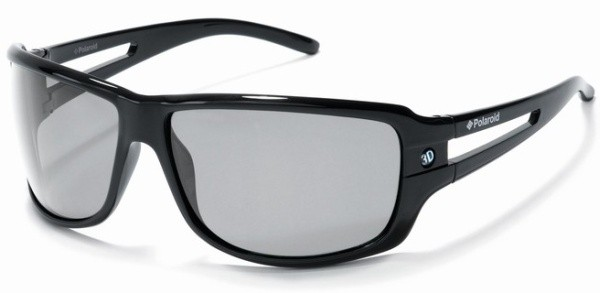
One of the problems of tricking the brain, making it believe that there is a 3D image being presented on a 2D surface, is when one eye is given a lot of information that is different from what the other eye is getting. This doesn’t typically happen in nature. But it does typically happen in a cinema theater because they can get extra information from EXIT signs, reflections from the neighbor’s 3D glasses or popcorn bucket, and especially from reflections from the rear of our own glasses. The reasons that people get headaches from 3D movies is not fully examined, and may be from multiple and varied sources, but one reason seems to be this problem of non-symmetrical images. Blocking much of this extra light is possible with substantive temple arms, regardless of how they look. (No one talks about your ears for example…as far as you know…)
Also, if the glasses fit better, then the reflection from the rear (including re-reflected light that comes from the skin below the eyes) would be less of a problem. But “free glasses” have to be substantial enough to be mis-handled and “one size fits all”, even though people’s faces are different shapes and sizes, and more importantly, so is the distance between people’s eyes (actually, people’s pupils, but I didn’t want to sound silly or get technical – the Inter-pupillary distance, the PD, is important for another 3D conversation.) One of the cool things about the Dolby glasses is that they are made from spherical glass, so that the distance from the lens to the pupil is the same, making it easier for the eye and eliminating edge distortion which is inherent with shaped lenses. But since the distance between people’s eyes can range from the low 4+ centimeters to the low 8+ centimeters, this is a problem that needs to be addressed, which the Polaroid press release says they have:
And prescription lens wearers are not forgotten, with a range of premium 3D cover styles that fit comfortably over any optical frame. There is even a junior style for the younger audience to enjoy.
But emphasizing the style issue is just plain wrong. They should be educating the public on why they need to block top and side light, which is not a ‘style-compatible’ issue. The ear stems must be bulky enough to block light entering from all directions.
Another benefit that Polaroid will hopefully bring is some consistency. One engineer reported that he recently measured 10 pair of 3D glasses, and none of the 20 lenses were close to being the same in terms of passing light and color.
What the press release doesn’t say is when and how much.
References: Schubin’sCafe has an article which explains many details of pupillary distance. He also describes several important 3D concepts, both in terms of cinema, and in terms of how it is not so simple to transfer digital “prints” and technology to 3DTV: The Other Three Dimensions of 3DTV
[1]Matt Cowen from RealD has made several presentations describing the several 3D clues that we have all used while watching 2D movies without stereoscopy, to understand where in space an article or person is relatively located.
3D; How It Works
Glasses also are relevant to darkness in the room, so these two articles might come in handy:
Scotopic Issues with 3D, and Silver Screens
23 degrees…half the light. 3D What?

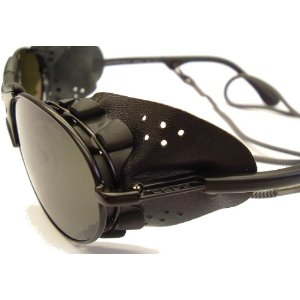
Not camera, not CGI.
Play the Google Code Instrument with the Radiohead data from 3 data gathering shoots.
In Radiohead’s new video for “House of Cards” from the album “In Rainbows”, no cameras or lights were used. Just data.
See the video and learn more about the technology behind it.
Stereographic 3D Cinematography Course
▪ August 28 – 30, 2010
(Three Days – Saturday/Sunday/Monday)
Registration and Additional Information here.
Theory, workflow and hands-on with the latest 3D rigs and HD camera systems. This is the first stage in the Santa Fe 3D Workshop Program, which is designed to provide increasingly advanced and intensive levels of S3D Cinematography training and testing.
The Los Angeles 3D Workshop is presented in association with VER 3D. And with Fujinon,IRIDAS, Angenieux, S.two, 1Beyond, Element Technica, More2Cam, DSC Labs, 3reedom Digital, Convergent Design and Fletcher Cameras & Lenses.
Instructors include Geoff Boyle, Aaron James, Maninder Saini, Mike Spodnik SOC, Bob Kertesz and Dan Kneece SOC. Guest speakers – Miles Shozuya, Fujinon; Steve Crouch, IRIDAS; Ted White, S.two Corp.; and George Palmer, Thales Angenieux.
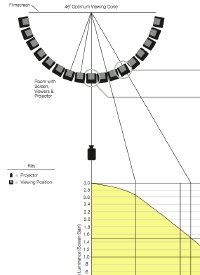 3D Luminance Issues—Photopic, barely. Mesopic, often. Scotopic? Who knows…?
3D Luminance Issues—Photopic, barely. Mesopic, often. Scotopic? Who knows…?
We don’t mean to be picking on the good people at Stewart Film Screens by making an example of their Silver Screen light rolloff curve. They just happen to grace us with the most usable graphic description of what is happening to our light. Looking at Harkness Screens Data Sheet for Spectral 240 3D Screens is not better and may be worse.
We know the problems of getting light to the eyes for any of the available 3D systems. The initial filter eats up to 50% of the light from the projector, plus the manner of each eye getting turned off 50% of the time, and the darkness of the glasses all steal a lot of light. If the projectors could produce enough light to overcome all these transmission problems…which they generally can’t…it would just mean more burnt expensive bulbs and higher electricity costs.
But even if the exhibitor cranks it as best as possible, and tweaks the room to get the best RGB balance at the best seats of the house, if the auditorium is using a ‘silver’ screen to maintain the polarity of the RealD or MasterImage system, the patron who is 23 degrees off the center-axis will have half the light available. Put another way, as you can see from the full picture at the Stewart site, 3 seats away from center is a totally different picture…as is the 4th and 5th, etc., as the situation just gets worse.
If the cinema had achieved 5 foot Lamberts (17 candela/m2) behind the glasses (most don’t get 3ftL – 10c/m2), then 3 seats off center will be 2.5ftL (8.5c/m2). At this point, bright reds have all turned to brick red or darker, and blues are becoming relatively dominant – it isn’t that there are fewer yellows or greens in the picture – it is that the eye becomes better able to discern the blue in the mix. (Another way to describe what is known as the Purkinje shift is that an object that appears greenish-yellow in brighter light will appear to be greenish blue as the intensity of the light descends lower than below 10 candelas/m2.) Combine that with stray light from a few EXIT signs, which not only mess with the contrast but puts non-symetrical data into the normally “practically-” symmetrical 3D mix, plus some reflections in the back of the eyeglasses and the patrons should not wonder why they don’t universally have an enjoyable experience.
We won’t beat this into a pulp since most real-life scenarios just get worse.
What will make it better?
Consumer education to begin, which is the real excuse for this article. Patrons must know what to insist upon.
Projectors can’t generate enough light to get 3D up to the 14ftL (48 candelas/m2) that 2D movies are shown at. But the new Series II projectors can do ‘more’ and industry tests show that ‘more’ is better, especially if the original was ‘mastered’ to be shown at ‘more’. James Cameron was prepared to ship theaters a ‘print’ of Avatar that was mastered at hotter levels for cinemas who asked for it…up to 10 ftL! Patrons must insist that if they are paying more for the experience, they should get better…perhaps 10ftL is not going to be the standard this year, but 7 or 8? Grass roots effort anyone? The studios set the intention in the DCI spec at 14, so one would think that they will come to the plate with ‘more’ if asked. [DCI Specification 1.2; page 48…and tell them that you want an order of Uniformity and some of that ±4 Delta E while they’re at it.]
The future also holds at least two potential ways that will give a better picture. Brian Claypool at Christie points out that one of the features of the Series II projector is “more native support for faster frame rates.” For example, many people in the creative community believe that higher frame rates will do more for image quality than having more pixel resolution. Again, Brian Claypool, “Do you remember how rich every frame was in Avatar, that your eye just kept wanting to look around? Well, imagine having 2 times as many frames for your eyes to follow… it will feel like looking out a window on another reality”.
{youtube}WgrdKmgniGI{/youtube}
The other, also long-term, change is replacing bulbs with lasers in the projectors. Good news on that front was announced by one player, Laser Light Engines. We deconstructed their newest announcement and some of their potential at: Laser Light Engines gets IMAX funding—Putting Light on the Subject.
Some mark this as digital cinema’s 11th year, but it wasn’t until 6 years ago that 2K was delivered, an example of the evolution of this industry.
Links: Luminance Conversion Table
Daniel Frankel’s 3 August The Wrap article presents these two graphs, but doesn’t allow them to speak for themselves…
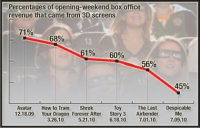
Patrick Goldstein in his LATimes article: No Surprises Dept.: Hollywood killing 3-D golden goose faster than expected begins with:
Whenever Hollywood finds a new cash cow, it dives in and loots its riches faster than any pickpocket on the planet. That’s what the movie industry has been doing with its much-ballyhooed 3-D technology, which has spawned one legitimate masterwork (“Avatar”) but otherwise has been little more than a cushy new revenue source for exhibitors and studios. Both have been raking in loads of moola from the extra $4 to $5 theater owners charge at the box office for admission to 3-D movies.
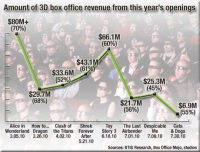 Both articles and their references are worth reading, but one should remember that when 4 or 5 movies come out in a row, and a guy has to drop over $30 for a pair of tickets plus all the other expenses, or a family drops about $100 per movie for four, that a recession might be worth a mention…regardless of how fun being right while knocking 3D happens to be.
Both articles and their references are worth reading, but one should remember that when 4 or 5 movies come out in a row, and a guy has to drop over $30 for a pair of tickets plus all the other expenses, or a family drops about $100 per movie for four, that a recession might be worth a mention…regardless of how fun being right while knocking 3D happens to be.
Common wisdom is that movies were the one arena that did well in the last recession. What is little noted (and shouldn’t be a surprise to the experts) is that there were a lot of marketing games, specials and attractions to keep the people coming into the cinemas during that era…not 50% addition to ticket prices. There also was a long list of alternative entertainment.
Finally, their premise of first weekend isn’t always a good indicator when the percentage of cinemas with 3D systems is still in the minority. So if, as was the case recently, several 3D movies get released simultaneously, something has to give. Fortunately the professional critics didn’t become economists…since that group doesn’t seem to be helping society recently either.
Looks like Google and Verizon were, in fact, in talks over Net Neutrality after all, calling it a “thorny” issue, no less. Hm. Both parties announced, a few moments ago, the creation of a codified framework that they will submit to lawmakers in hopes of being enshrined into law. Many of the ideas are fairly benign, such as giving the FCC power to regulate the Internet a little more forcefully. (A recent court case has rendered the FCC’s power somewhat uncertain.) Other ideas, such as the wholesale exclusion of wireless Internet from any sort of Net Neutrality controls, are a little more controversial.
The framework includes seven main points: supporting the FCC’s openness guidelines; steps should be taken to prevent a so-called “tiered” Internet from arising on current Internet infrastructure; ISPs should be upfront to its customers how they handle their data (see Comcast’s constant struggle with BitTorrent traffic); making the FCC the sole arbiter when it comes to regulating the Internet; giving ISPs the power to offer “additional, differentiated online services, in addition to the Internet access and video services (such as Verizon’s FIOS TV) offered today”; the wholesale exemption of wireless broadband from any of these proposals or ideas; and to promote the idea that broadband access for all Americans is in the “national interest.”
Two of the five deserve a closer look: points five and six, those dealing with “additional, differentiated online services” and wireless broadband access.
To me, point five seems like carte blanche for the creation almost of a second Internet. The Internet you know and love, the one that has worked fairly well so far, will remain in palce, but ISPs will be allowed to offer “additional, differentiated online services” as they see fit.
Read the full CrunchGear Article at: Not Neutrality: Did Google & Verizon Just Stab The Internet In The Heart? It is partly worry because of anecdotes…well, and precedents…and the things they say…and they things they don’t say…